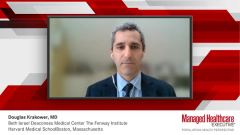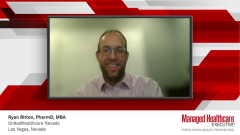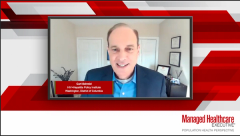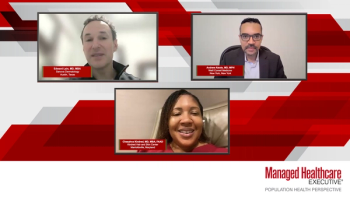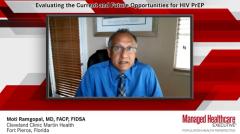
Addressing Disparities and Increasing Access to HIV PrEP
Strategies that can help address disparities in care for patients with HIV and reach high-risk groups of patients to ensure access to screening and PrEP.
Episodes in this series

Douglas Krakower, MD: We really need to think about ways to improve access to PrEP [pre-exposure prophylaxis] across all populations, especially in populations where HIV risk is highest and access to PrEP has been lowest. In terms of general access to PrEP, 1 thing my colleagues and I have advocated for is a routine conversation about PrEP. CDC [Centers for Disease Control and Prevention] guidelines, which were just updated for PrEP, emphasized the approach that clinicians should discuss PrEP with every sexually active adolescent and adult in America. The previous guidelines said that it should be discussed with people who may be at increased risk for HIV. But they did the right thing by broadening this, saying that clinicians should make this a routine part of primary care and that it should be integrated just as we ask people about family planning, seatbelts, and tobacco and alcohol use.
This is a piece of well-being that we need to integrate into routine health care. If we do that, then many more people will learn about PrEP just from being asked if they’ve heard of it and if they’re interested in it. Even if people say it’s not for them, they’ll learn about it. Maybe they’ll talk to their peers, family, and friends about it. That’s 1 way to do it—making PrEP conversations routine. With CDC guidelines endorsing that, health care organizations need to think about ways to do this.
In terms of other ways to improve access to PrEP, we need to meet people where they’re at. For some people who have psychosocial challenges to accessing health care and maintaining healthy behaviors, getting outside the traditional clinical setting is important. Whether it’s embedding PrEP in sterile syringe programs for people who inject drugs or working with programs that provide health care to people who have marginalized housing. That’s a great model. Some people don’t have stable housing but are willing to engage with health care programs. We have some excellent ones in Boston. For example, the Health Care for the Homeless Program has developed tremendous expertise at delivering general health care. Also, we have PrEP care for people who may not have stable housing. For populations that have mental health conditions—depression, anxiety, PTSD [post-traumatic stress disorder]—that get in the way of accessing health care and adhering to PrEP medication, we need to think very broadly about ways to engage clinical psychologists and nurses and the whole health care team to help people treat their behavioral health challenges and get them access to PrEP.
In the future, hopefully there will be more PrEP options, given that long-acting injectable agents are under FDA review and might be available as early as the first quarter of 2022. We need to think about using those options to engage new populations that have underused PrEP thus far. For people injecting drugs and coming to sterile syringe programs, if they’re coming frequently to a program like that, that’s a great time to offer people PrEP.
I was with a colleague recently who has been administering Suboxone methadone as part of a program and is eager to layer in PrEP. They’ve done it successfully with oral PrEP. When there are longer-acting options, it will be a nice synergy for certain populations.
The same will be true for other populations that have trouble accessing health care and taking a daily pill. For example, adolescents and young adults who have busy lives and are still developing in terms of social and brain development, taking a pill—if you’re otherwise healthy—might be a new phenomenon for them. [We need to] think about ways to improve access by engaging pediatricians, adolescent medicine specialists, and college health clinics and using oral and, hopefully in the future, long-acting options for people who are younger and getting introduced to a new idea of taking a pill or getting injection. All those will be ways to engage important populations in PrEP. I’m very optimistic that the future holds ways to improve PrEP on a population level if we think intelligently and intentionally about accessing these populations.
Moti Ramgopal, MD, FACP, FIDSA: The disparities and inequities of access have a lot to do with stigma. It has to do a lot with insurance providing treatments and coverage for PrEP. What we do as an organization or a clinic is to try to go to those communities where we think there will be high risk. We have partnerships with MSM [men who have sex with men] groups. We have partnership with a lot of local groups that have that peer support and navigation tools. We partner significantly with groups that can advise patients and bring them into care. The question is also, here’s an African American or Latinx person, they’ll feel as though, “I don’t need it for A, B, and C reasons.” How do we get that person to understand and break that inequity challenge? They’re uninsured. How can we get that person into believing that even though you’re uninsured, you can still be in PrEP because we have patient-assistance programs.
Douglas Krakower, MD: In terms of disparities and inequalities in access to PrEP, we need to access all the tools we’ve discussed. We need to invest resources in the communities and places in the United States that have been slower to have PrEP uptake. The CDC and the federal government have the Ending the HIV Epidemic initiative, which emphasizes investing our prevention resources most aggressively in 48 hot spot counties and 7 rural states. Their goal is to end the HIV epidemic by decreasing new infections by 90% by 2030.
That’s a good way to look at this from the start: where are the HIV infections happening most frequently, and where is PrEP use lowest? Those hot spot areas are a good place to look. We also need to think about racial and ethnic inequities. There’s been a long history of racism in health care and discrimination against Black and Latinx populations. We need to engage clinicians, organizations, and patients in a new conversation about making health care welcoming and inclusive, an environment where everyone can feel like they’re going to get effective and personalized health care. This is also true for people who may be transgender or nonbinary in terms of their gender identity, who have faced health care discrimination and societal discrimination for a long time. We need to get the health care system to be as welcoming and inclusive as possible.
If we do that, then hopefully communities where PrEP has been underutilized will see this as something that is a feasible, acceptable, and attractive thing that people are motivated to use. Then it benefits the patients and the health care system as well for all the reasons we’ve discussed in terms of the economic and population public health impact of HIV in the United States.
Transcript edited for clarity.
Newsletter
Get the latest industry news, event updates, and more from Managed healthcare Executive.

